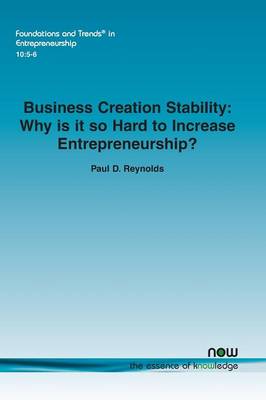Foundations and Trends in Entrepreneurship
2 total works
While much attention has been given to the dramatic global diversity in business creation-some countries have over ten times the activity of others-there has been less attention to the year to year consistency found in individual countries. This stability has occurred despite considerable government efforts in many countries to increase the level of activity. This leads to a major question: What accounts for the high level of temporal stability in business creation? The answer can be found in Business Creation Stability and has considerable implications for policies oriented toward increasing new firm creation. There has been research studying the level of business creation stability across regions within countries including the United States, the United Kingdom and Germany, and in all three cases, regions at the top and the bottom of the rank orders appear in the same positions over time. This pattern suggests that some stable national characteristics-or basic institutional features-are affecting individual decisions to participate in the firm creation process.
The central challenge, then, is how to identify national factors that are both relatively stable and likely to have a major effect on decisions to participate in business creation. Business Creation Stability presents a conceptual model and strategy for assessment of this phenomenon. The final result is a more complete understanding of both the critical national features and the underlying processes affecting participation in business creation. The major policy implication that substantial increases in business creation will require a sustained multi-faceted approach is discussed in the conclusion.
The central challenge, then, is how to identify national factors that are both relatively stable and likely to have a major effect on decisions to participate in business creation. Business Creation Stability presents a conceptual model and strategy for assessment of this phenomenon. The final result is a more complete understanding of both the critical national features and the underlying processes affecting participation in business creation. The major policy implication that substantial increases in business creation will require a sustained multi-faceted approach is discussed in the conclusion.
The primary objective of Start-up Actions and Outcomes: What Entrepreneurs Do to Reach Profitability is to provide a description of the firm creation process based on five harmonized data sets from four countries that track the business creation process. The second objective is to explore the role of start-up activities on the outcomes for these nascent ventures. Outcomes include not only whether they reach profitability or disengage but how long it takes to achieve a resolution. The sooner a start-up team can determine if a nascent venture is profitable or hopeless, the lower the sunk costs. The presentation begins with a review of the conceptualization of business creation. This is followed by a discussion of assessments of the role of business planning, the start-up activity that has received the most attention in relation to outcomes. A summary of the Panel Study of Entrepreneurial Dynamics (PSED) protocol describes the basis for the five cohort data set. To identify the impact of different background factors and start-up domains on outcomes, two assessments are completed. First, linear additive models are developed using stepwise regression.
Second, interactions among factors are identified using a three level decision tree assessment. In both, there are major differences related to the host country and the total amount of start-up activity. To identify the impact of specific start-up domains, the assessments are replicated without measures of total start-up activity. The final section summarizes the major patterns and the implications for those starting new firms, developing public policy, or planning the next stages of research.
Second, interactions among factors are identified using a three level decision tree assessment. In both, there are major differences related to the host country and the total amount of start-up activity. To identify the impact of specific start-up domains, the assessments are replicated without measures of total start-up activity. The final section summarizes the major patterns and the implications for those starting new firms, developing public policy, or planning the next stages of research.

